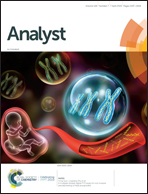Target-induced structure switching of aptamers facilitates strand displacement for DNAzyme recycling amplification detection of thrombin in human serum
Abstract
To monitor the thrombin concentration under the condition of abnormal blood coagulation is of clinical significance for the diagnosis of various diseases. Here, on the basis of the aptamer structure switching induced by the target molecules and the signal amplification strategy via recycling of metal-ion dependent DNAzymes, we have established a sensitive and simple fluorescent aptasensor for detecting thrombin in human serum. The thrombin target specifically binds to the aptamer sequence and causes a corresponding conformational structure switching, which leads to the formation of a toehold sequence to facilitate the strand migration displacement reaction for the generation of functional metal-ion dependent DNAzymes. These DNAzymes further cleave the fluorescently quenched hairpin substrates cyclically to yield substantially amplified fluorescence recovery for sensitively detecting thrombin in the dynamic range from 0.01 nM to 50 nM. Such an aptasensor shows a detection limit of 6.9 pM and can achieve the monitoring of thrombin in diluted human serum with high selectivity, offering a universal sensing strategy for the construction of various sensitive and simple aptasensors to detect different biomarker molecules.



 Please wait while we load your content...
Please wait while we load your content...